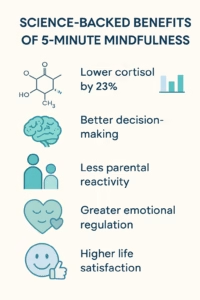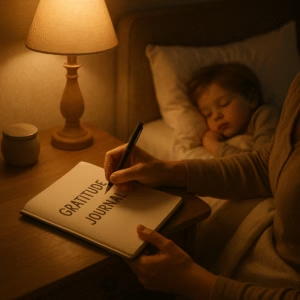Parenting in 2025 feels like running a marathon while juggling flaming torches. Between work deadlines, toddler tantrums, and the never-ending mental load of family life, finding time for traditional self-care can feel impossible. But what if meaningful stress relief didn’t require an hour of meditation or a spa day? The solution lies in micro mindfulness—simple, 5-minute practices that can transform your most overwhelming moments into opportunities for peace and reset. These aren’t just feel-good concepts; they’re evidence-based techniques that busy parents are using to reclaim their sanity, one breath at a time.
Micro mindfulness is the practice of incorporating brief, intentional moments of awareness into your existing routine. Unlike traditional meditation that requires dedicated time and space, micro mindfulness works within the chaos of daily life.
Research shows that even brief mindfulness practices can activate your parasympathetic nervous system—your body’s “rest and digest” mode—reducing cortisol levels and improving emotional regulation within minutes. For parents managing chronic stress, these small interventions can be surprisingly powerful.
The beauty of micro mindfulness lies in its accessibility. You don’t need special equipment, a quiet room, or even uninterrupted time. These practices work in the carpool line, during naptime, or even in the bathroom—often the only guaranteed private space for busy parents.
Let’s be honest: when parenting experts suggest “take time for yourself,” it can feel tone-deaf. Between the demands of work, childcare, and household management, carving out large blocks of time feels impossible.
The reality of modern parenting includes:
-
Mental load that never stops
-
Interrupted sleep cycles
-
Constant vigilance for children’s needs
-
Limited childcare support
-
Financial pressures that eliminate traditional self-care options
This is where micro mindfulness becomes revolutionary. Instead of adding another item to your overwhelming to-do list, it transforms existing moments into opportunities for restoration.
The Science Behind 5-Minute Resets
Neuroplasticity research reveals that consistent, brief mindfulness practices can literally rewire your brain for better stress management. Even five minutes of focused attention can:
-
Lower cortisol levels by up to 23%
-
Improve decision-making under pressure
-
Reduce parental reactivity during challenging moments
-
Enhance emotional regulation
-
Boost overall life satisfaction
Dr. Kristin Neff’s research on self-compassion shows that parents who practice brief mindfulness techniques report feeling more patient, present, and emotionally available for their children. The key isn’t duration—it’s consistency.
5 Essential Micro Mindfulness Techniques
1. The Kitchen Counter Breathing Reset
When to use: While coffee brews, dinner cooks, or kids eat breakfast
How it works: Place both hands flat on the kitchen counter. Feel the coolness of the surface beneath your palms. Take five deep breaths, focusing on the physical sensation of your hands connecting with something solid and stable.
Why it’s effective: This practice grounds you in the present moment while using an anchor point (the counter) that’s always available. The physical connection helps activate your body’s relaxation response.
Parent-tested tip: Practice this every morning while your coffee brews. Those 90 seconds of intentional breathing set a calmer tone for the entire day.
2. The Carpool Line Body Scan 
When to use: Waiting in pickup lines, during naptime, or while kids play independently
How it works: Starting from the top of your head, slowly notice each part of your body. Are your shoulders tense? Is your jaw clenched? Simply notice without judgment, then consciously relax each area as you scan downward.
Why it’s effective: Body scanning helps you identify and release physical tension you might not realize you’re carrying. It’s like a gentle massage for your nervous system.
Real-world application: Use red lights as your cue to do a quick body scan. By the time the light turns green, you’ll feel more relaxed and focused.
3. The Bathroom Sanctuary Moment
When to use: Your only guaranteed private space (often the bathroom)
How it works: Before you open the door to return to family chaos, take three deep breaths. Set an intention for how you want to show up—patient, present, or peaceful. Place your hand on your heart and offer yourself a moment of compassion: “This is hard, and I’m doing my best.”
A URPOWER Essential Oil diffuser may make the bathroom a more inviting sanctuary!
Why it’s effective: This creates a buffer between stressful moments and your response, allowing your prefrontal cortex (the thinking brain) to come back online.
Parent reality check: Yes, sometimes kids bang on the door. Even 30 seconds of intentional breathing makes a difference.
4. The Bedtime Gratitude Practice
When to use: After kids are finally settled, before you check your phone or tackle evening tasks
How it works: Identify three specific moments from the day you’re grateful for. Not generic gratitude (“I’m grateful for my family”) but specific instances (“I’m grateful for how my toddler shared his snack with his sister”).
Why it’s effective: Gratitude practices rewire your brain to notice positive moments, creating a buffer against the day’s stress. It’s like training your mind to see the highlights reel instead of just the bloopers.
Sleep bonus: This practice naturally transitions your mind toward rest, improving sleep quality—something every parent desperately needs.
5.
When to use: Before checking your phone, during those first quiet moments of consciousness
How it works: Before your feet hit the floor, take five conscious breaths. Ask yourself: “How do I want to feel today?” Choose one word—calm, patient, present—and let it guide your morning actions.
Why it’s effective: Starting the day with intention rather than reaction sets a foundation for more mindful choices throughout the day.
Practical tip: Keep a notepad by your bed to jot down your daily intention. Seeing the pattern over time can be surprisingly motivating.
Making It Stick: The Habit Stacking Approach
Successful habit stacks for parents:
-
After buckling kids into car seats, take three deep breaths before starting the car
-
While kids brush teeth, do a quick body scan
-
After pouring your morning coffee, set your daily intention
-
Before opening your laptop for work, take five conscious breaths
-
After putting kids to bed, practice gratitude before checking your phone
Start small: Choose just one technique and practice it for a week before adding another. Consistency matters more than complexity.
Involving Your Kids (Optional)
Micro mindfulness can become a family practice without adding pressure to your routine:
Simple breathing exercises for children 3+:
-
“Balloon breathing”: Pretend to blow up a balloon with slow, deep breaths
-
“Smell the flower, blow out the candle”: Inhale to smell an imaginary flower, exhale to blow out a candle
-
“Animal breathing”: Breathe like a sleeping bear (slow and deep) or an excited bunny (quick and light)
Modelling mindfulness: Children learn more from what they observe than what we tell them. When they see you taking intentional pauses, they internalize that it’s normal to slow down when feeling overwhelmed.
Keep it optional: Some days, mindfulness is a solo practice, and that’s perfectly fine. The goal isn’t to create another family activity—it’s to give yourself tools for managing stress.
Overcoming Common Obstacles
-
“I Don’t Have Time”
You have time to scroll social media, so you have time for micro mindfulness. These practices take less time than checking Instagram. -
“My Mind Won’t Stop Racing”
A racing mind is normal, especially for parents. Mindfulness isn’t about stopping thoughts—it’s about changing your relationship with them. Notice the racing thoughts without judgment, then gently redirect attention to your breath. -
“I Keep Forgetting”
Use your phone strategically. Set gentle reminders with compassionate messages: “Time for your 5-minute reset” or “Remember to breathe, you’re doing great.” -
“I Feel Guilty Taking Time for Myself”
Taking care of your mental health isn’t selfish—it’s modeling healthy coping skills for your children. You can’t pour from an empty cup.
The Ripple Effect: How Your Practice Affects Your Family
When parents practice micro mindfulness consistently:
-
Children experience more patient, present caregivers
-
Family conflict decreases as parents respond rather than react
-
Household stress levels drop, creating a calmer environment for everyone
-
Children learn healthy stress management by observation
“I started doing the kitchen counter breathing while my coffee brewed. Within two weeks, my 4-year-old started copying me. Now when he’s upset, he puts his hands on the table and takes ‘big breaths’ like Mommy. I accidentally taught him a coping skill just by taking care of myself.” — Sarah, mother of three
Creating Your Personal Micro Mindfulness Toolkit
-
Week 1: Choose one technique that resonates with you. Practice it daily at the same time.
-
Week 2: Add a second technique, stacking it with an existing habit.
-
Week 3: Experiment with using your techniques during stressful moments, not just scheduled times.
-
Week 4: Notice the changes—better sleep, more patience, feeling less overwhelmed.
Remember: some days you’ll practice all five techniques, other days maybe just one, and some days none at all. This isn’t about perfection—it’s about having tools available when you need them.
Progress, Not Perfection
Micro mindfulness isn’t another item on your parenting to-do list—it’s a gentle way to find moments of peace within the beautiful chaos of family life. These practices work because they meet you where you are, requiring nothing more than the willingness to pause and breathe.
Your children don’t need a perfect parent—they need a present one. And sometimes, presence begins with a single, conscious breath in the kitchen while the coffee brews.
Finished working on your outlook? Work on your body next! 5 Exercises to Bulletproof Your Body (No Equipment Needed)
